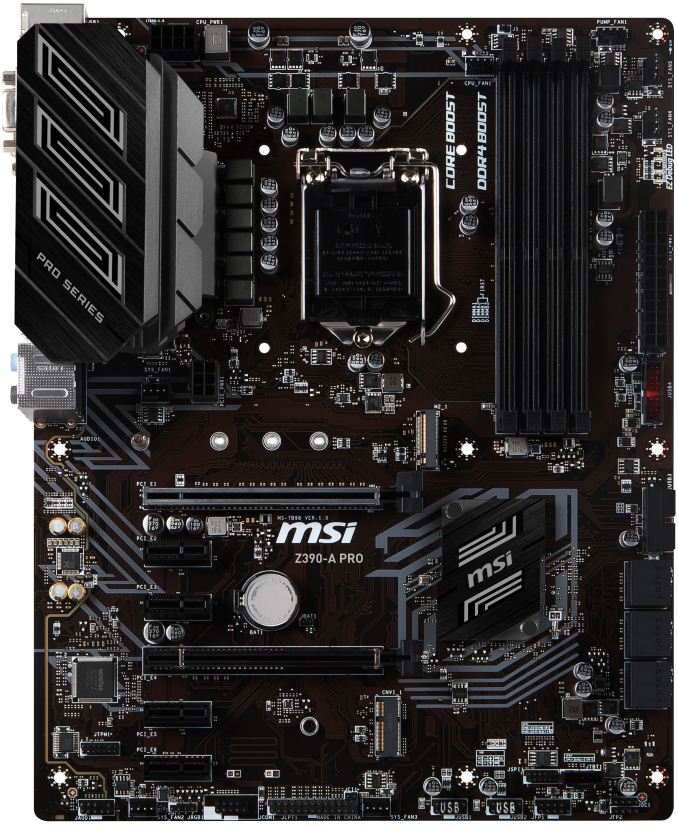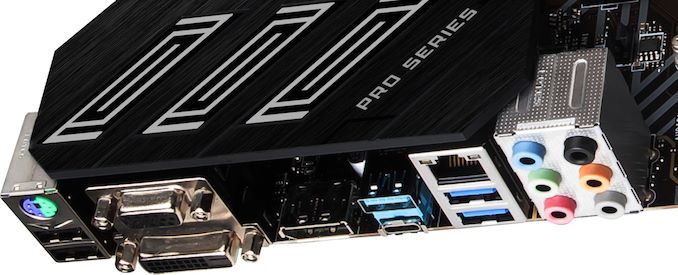Intel Z390 Motherboard Overview: 50+ Motherboards Analyzed
by Ian Cutress & Gavin Bonshor on October 8, 2018 10:53 AM EST- Posted in
- Motherboards
- Intel
- MSI
- Gigabyte
- ASRock
- EVGA
- Asus
- NZXT
- Supermicro
- Z390
MSI Z390-A PRO
The main difference between the MSI Z390-A PRO and the rest of MSI's Z390 product stack is that this board isn't specifically targeted towards gamers. The aesthetics are simple with a coffee colored PCB which does include silver patterning across it; primarily around the edges of the board and around the silver and black heatsinks. The main selling point of the MSI Z390-A PRO is in its value with a good selection of controllers including an Intel I219V Gigabit Ethernet controller and a Realtek ALC892 HD audio codec handling the onboard audio.
On the board are two full-length PCIe 3.0 slots with the top MSI Steel Slot coated slot running at x16 and the second full-length slot operating at x4. Also present is plenty of PCIe 3.0 x1 ports as the Z390-A PRO has four in total. The storage options are pretty basic on the Z390-A PRO with this being the only Z390 MSI board to feature only one PCIe/SATA M.2 slot; this is complemented by a total of six SATA ports with support for RAID 0. 1. 5 and 10 arrays. In terms of memory, the board is packing four RAM slots with support for DDR4--4400 with a maximum capacity of up to 64 GB.
Rear panel connections wise the MSI Z390-A PRO has a USB 3.1 Gen2 Type-A and Type-C port and four USB 2.0 ports; up to two USB 3.0 and four USB 2.0 ports can be made available through the use of internal headers. A total of six 3.5 mm audio jacks are powered by a Realtek ALC892 HD audio codec and a single LAN port controlled by an Intel I219V Gigabit networking chip. The Z390-A PRO is the only MSI board to include a D-Sub video output which seemingly replaces the HDMI and also included is a DisplayPort and DVI-D output.
The MSI Z390-A PRO is the cheapest Z390 motherboard from MSI at launch with a suggested retail price of $140 which all things considered is still quite expensive for chipsets entry-level model. The board makes use of a decent set of controllers which further hikes the price up and it seemingly means users are going to have to look at adding a little more cash to their budget in order to jump onto MSI's Z390 platform; especially compared with the equivalent models when the Z370 chipset debuted.












79 Comments
View All Comments
Valantar - Wednesday, October 10, 2018 - link
That would be pretty shocking, yeah, but the sheer size of that lump of metal still has me a bit worried. Guess that's what you get when you try to squeeze power delivery for a CPU that (likely) pulls >300W when overclocked into an ITX board (and refuse to use riser boards like before, for some reason).FXi - Monday, October 8, 2018 - link
The power feed also changed with z390 I believe at least in the Asus models it did. The power feed of the 370 was "enough" to drive the newer 9700/9900 but there is a difference there that may impact enthusiasts. I don't think it enough to warrant an upgrade but something to consider.Also people should remember that while it is still a bit of a ways off, wifi is going to change to Wifi6 or 802.11ax starting now and probably seeing much of the changeover during 2019/2020 depending on adoption choices. And there is also pci-e 4.0 to consider next year probably that should be thought about before people do "marginal" upgrades from 370 era chipsets.
FXi - Monday, October 8, 2018 - link
Silly thing posted in edit window. Sorry power delivery and other points covered by you. Would have edited if I could have found that optionDanNeely - Monday, October 8, 2018 - link
Other things to look forward to in the next few generations are: Less-hacky USB3.1 implementations (eg this articles speculation that a 10g port will need to eat 2 HSIO lanes instead of 1, and still needing an extra chip to support USB-C). Spectre/Meltdown fixes in hardware. A reduced DMI bottleneck between the CPU and chipset (either just from upgrading the link to PCIe4/5, moving some of the peripheral IO onto the CPU, or both.Valantar - Wednesday, October 10, 2018 - link
Considering that the maximum theoretical bandwidth of PCIe 3.0 x1 is 984.6MB/s, you _need_ two PCIe lanes (and thus two HSIO lanes) for a USB 3.1G2 (1.25GB/s) controller unless you want to significantly bottleneck it. That's not "hacky", that's reality, even if this leaves a lot of bandwidth "on the table" if this only powers a single port (which it rarely does, though, and given that a full load on two ports at one time is unlikely, running two 1.25GB/s ports off two .99GB/s lanes is a good solution).Moving DMI to PCIe 4.0 will be good, though, particularly for multiple NVMe SSDs and >GbE networking.
DanNeely - Wednesday, October 10, 2018 - link
Splitting the traffic over 2 HSIO lanes is a hack because it'd require something to split/combine the traffic between the chipset and usbport. That in turn has me wondering if the speculation about the implementation being done that way is correct, or if the Z390 has 6 HSIO lanes that can run 10Gbps instead of the 8 that the rest top out at for PCIe3repoman27 - Thursday, October 18, 2018 - link
The implementation is absolutely not done that way. HSIO lanes are simply differential signaling pairs connected to a PCIe switch or various controllers via a mux. The PCH has a 6-port USB 3.1 Gen 2 xHCI, which can only feed 6 HSIO muxes. The back end of that xHCI is connected to an on-die PCIe switch which in turn is connected to the DMI interface. That DMI 3.0 x4 interface is already massively oversubscribed, but it is at least equivalent to a PCIe 3.0 x4 link, which is the most bandwidth that can be allotted to a single PCH connected device.Srikzquest - Monday, October 8, 2018 - link
HDMI 2.0 is available in Asus and Gigabyte's ITX boards as well.gavbon - Tuesday, October 9, 2018 - link
Thank you Srikzquest; updated the tables, obviously missed this yesterday :) - Thanks againHickorySwitch - Monday, October 8, 2018 - link
Correction:https://www.asus.com/us/Commercial-Servers-Worksta...
It says under "Specifications" that the board sports HDMI 2.0[b?]